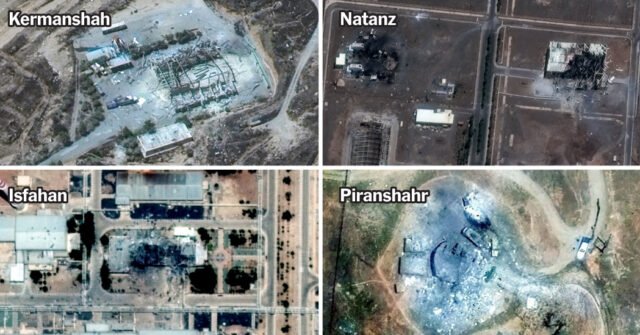Israel’s largest attack ever against Iran has targeted nuclear and military facilities, gas and oil depots and the government-run broadcaster. More than 200 people have been killed and hundreds more injured.
Iranian facilities hit by Israeli attacks
Here is what is known about the damage to Iran’s strategic infrastructure so far.
Nuclear facilities
Israel launched its most recent attack against Iran last Friday with waves of coordinated airstrikes hitting nuclear sites and killing much of the country’s military chain of command, along with several nuclear scientists.
Iran’s nuclear industry is well established, with over 30 facilities spread over the country, and some buried deep underground.
Iranian nuclear facilities attacked
The first strikes severely damaged Iran’s largest uranium enrichment center, at Natanz, about 140 miles south of Tehran.
The International Atomic Energy Agency, the U.N. nuclear watchdog, initially reported that the strikes had damaged only the aboveground part of the enrichment plant. It later revised its assessment to confirm “direct impacts” on underground enrichment halls.
Satellite imagery taken two days after the strike shows the tracks of heavy machinery and piles of dirt covering craters above where the enrichment halls are believed to be built.
Isfahan Nuclear Technology Center
Iran’s most likely repository of near bomb-grade nuclear fuel is stored at a complex outside the ancient capital of Isfahan. The stockpile has so far been spared from attack, but the Israeli military struck laboratories that work to convert uranium gas back into a metal — one of the last stages of building a weapon.
As of Wednesday morning, Iran’s most heavily fortified nuclear site, Fordo, remained undamaged. It was built deep inside a mountain to protect it from attack. Only the U.S. military has a bomb capable of even reaching it.
Striking Fordo is central to any effort to destroy Iran’s ability to make nuclear weapons.
The site appeared to be intact in this satellite imagery taken on June 14.
A few other important nuclear facilities remain undamaged. Among them is Bushehr, Iran’s only operating nuclear plant, and Arak, a heavily guarded complex that has long been suspected of being built to produce plutonium.
Israel also targeted at least one university associated with nuclear programs. In an image posted on social media and verified by The New York Times, black smoke can be seen billowing from the Institute of Applied Physics’s campus.
There are a few other institutions in the area that are also associated with Iranian nuclear programs, including Shahid Rajaee University and Malek Ashtar University of Technology. Both are under U.S. sanctions. American officials believe they participate in research on nuclear warhead design.
Missiles bases
Iranian missile capability was also degraded by the strikes. The Israeli military said that it had struck 12 missile launch sites and storage facilities on Tuesday alone.
Several Israeli strikes targeted a missile base in Kermanshah, where missile storage buildings can be seen with damage in a satellite image taken on June 15.
Satellite imagery also shows damage at tunnel entrances to underground missile facilities.
In addition to Kermanshah, multiple other missile facilities were hit.
Energy infrastructure
With the second-largest gas reserves in the world and the fourth-largest crude oil reserves, Iran is one of the world’s major energy producers.
Iranian energy facilities
Over the weekend, Israel targeted Iran’s critical energy infrastructure. It struck Tehran’s main gas depot and its central oil refinery, according to a statement from Iran’s oil ministry. The ministry said Israel had also targeted a section of one of the world’s largest gas fields.
Video posted to social media and verified by The Times shows a large fire burning at the Shahran oil depot, north of Tehran.
Other infrastructure
On Friday, Israel carried out a strike on a military airport in the northwest Iranian city of Tabriz. A video taken by a witness and verified by The Times shows large plumes of black smoke rising into the sky.
And on Monday evening, the Israeli military attacked the headquarters of Iran’s state television. A news anchor was speaking live on the air when an explosion shook the building, followed by the sound of breaking glass and screams.















